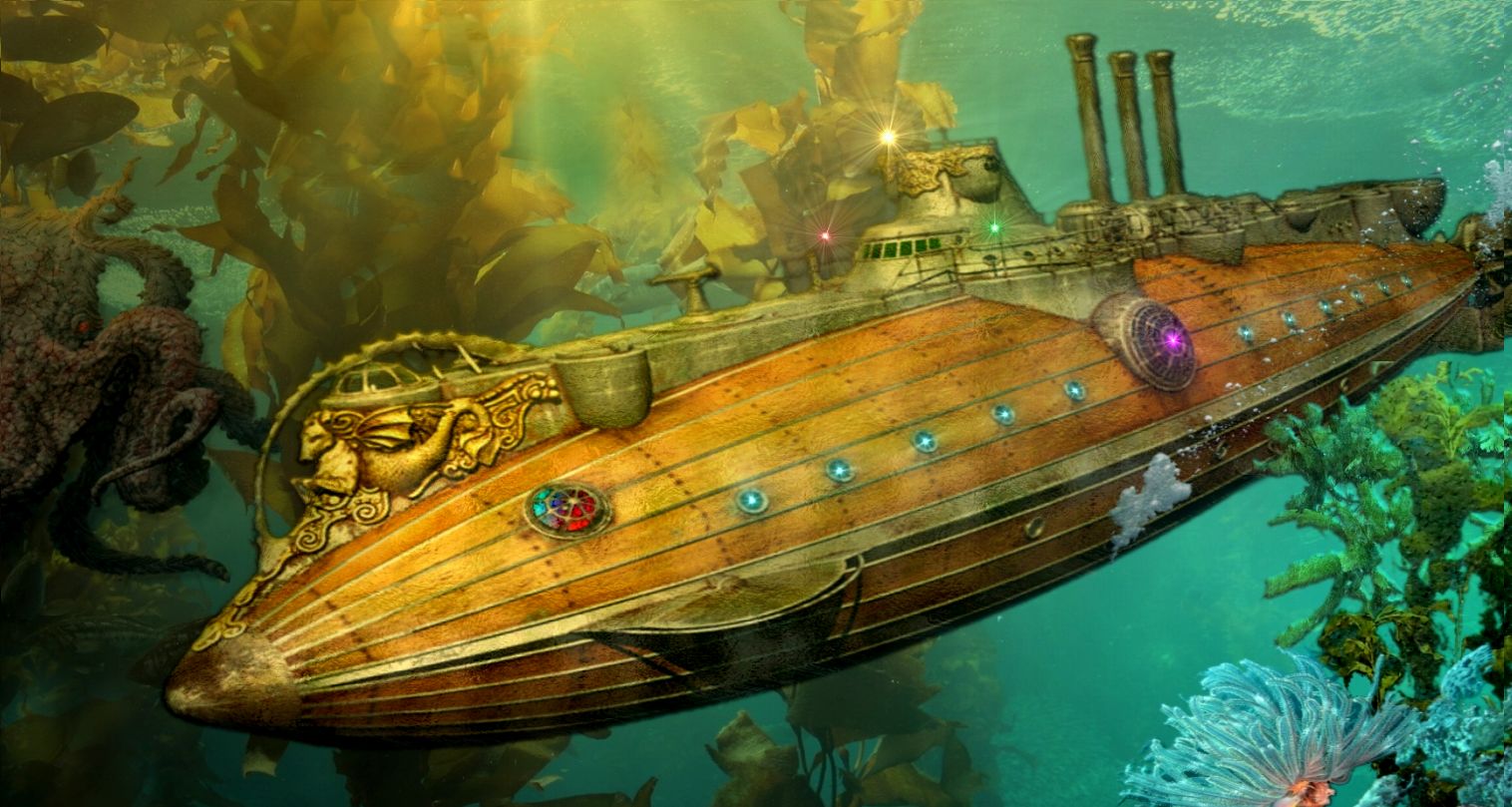|

Best
known for '20,000
Leagues Under the Sea' and Around
The World In Eighty Days, Jules Verne also authored a number of
other popular novels, that made it onto the big screen, such as 'The
Mysterious Island,' and 'Journey To The Centre Of The World.'
Facing the Flag or For the Flag (French: Face au drapeau) is
a patriotic novel by Jules Verne from 1896. The book is part of the Voyages extraordinaires series.
Like The Begum's Millions, which Verne published in 1879, it has the theme of France and the entire world threatened by a super-weapon with the threat finally overcome through the force of French patriotism.
PLOT
Thomas Roch, a brilliant French inventor, has designed the Fulgurator, a weapon so powerful that "the state which acquired it would become absolute master of
earth and
ocean." However, unable to sell his unproven idea to France or any other government, Roch begins to lose his sanity, becoming bitter, megalomaniacal and paranoid. The United States Government reacts by tucking him away at a luxurious asylum in New Bern, North Carolina, where he is visited by one "Count d'Artigas"
- actually Ker Karraje, a notorious pirate of Malagasy origin. His heterogeneous crew is drawn from "escaped convicts, military and naval deserters, and the scum of Europe."
Karraje and his crew lead double lives. Karraje goes around openly, under the alias of "Count d'Artigas", a pleasure-loving, slightly eccentric but eminently respectable member of nobility. He is a regular visitor to the ports of the East Coast aboard his schooner Ebba. To outward appearances, Ebba has no other means of propulsion than its sails, but in fact, it is pulled by an underwater tug. By this means, Karraje and his crew can pull up to becalmed sailing vessels without raising suspicion and board them without warning. They then rob and massacre the crews, scuttling the ships, adding to the statistics of "unexplained disappearances".
Karraje hears of Roch and his invention takes them both seriously and decides to gain possession of them. Actually, his aim is rather modest. He has no intention to seize mastery over the world, but just to make his hide-out impregnable. He and his men successfully kidnap Roch from his American asylum, and then bring him to their
hide-out - the desolate island of Back Cup in the Bermudas. Here a wide cavern, accessible only by submerged submarine, has been made into a well-equipped pirate base. It has its own electrical power plant and is completely unknown to the rest of the world.
During the kidnapping, however, Karraje orders his men to also take along Gaydon, Roch's attendant for the past fifteen months. The reader knows (and, as is later shown, Karraje is also aware) that Gaydon is actually Simon Hart, a French engineer and explosives expert. Hart had decided "to perform the menial and exacting duties of an insane man's attendant" in the hope of learning Roch's secret and, thereby, saving it for France, actuated by "a spirit of the purest and noblest patriotism."
Hart is kept imprisoned at the pirate base, though in quite comfortable conditions. He can only watch in dismay as the pirate chief easily manages what four governments in succession have failed to do: win Roch over. Roch is given "many rolls of dollar bills and banknotes, and handfuls of English, French, American and German gold coins" with which to fill his pockets. Further, Roch is formally informed that the entire secret cavern and all in it are henceforward his property, and egged on to "defend his property" against the world which has wronged him so badly. Soon, the inventor is busy constructing his fearsome weapon, happily unaware that he is nothing but a glorified prisoner in the
pirate's hands.
The paranoid Roch does, however, keep to himself the secret of the detonator or "Deflagrator", a liquid without which the explosive is merely an inert powder. By holding fast to that last secret, Roch unwittingly preserves the life of his ex-keeper Gaydon/Simon Hart. Karraje suspects, wrongly, that Hart knows much more of Roch's secrets than he is willing to let on. It serves the purposes of the pirate chief, a completely ruthless killer, to let Hart live. The pirate engineer Serko, Hart's "colleague," hopes to win him over in prolonged friendly conversations. Hart's reticence is misunderstood as proof that he has something to hide.
The pirates underestimate Hart, giving him a practically free run of their hide-out since the only way out is via submarine. But after carefully studying the currents, Hart succeeds in secretly sending out a message in a metal keg, giving the full details of Karraje's operations and his impending acquisition of the Fulgurator.
The message gets through to the British authorities at their nearby naval base in Bermuda, and the British Navy sends a
submarine, HMS Sword, to find Hart. The submarine's crew makes contact with Hart, and take him and Roch on board, but the Sword is discovered, attacked and sunk by the
pirates in a direct underwater submarine vs. submarine battle. The unconscious Hart and Roch are extracted from the sunken British sub by pirate divers, leaving the entire British crew to perish. Hart manages to convince the
pirates that he had been kidnapped by the British sailors and had nothing to do with their "visit." He resumes his role as a tolerated prisoner with a free run of the
pirate base.
Meanwhile, Roch's weapon is completed and becomes operational. A hastily gathered international naval task force approaches the island, consisting of five warships dispatched by the world's five largest powers.
The weapon, operated personally by Roch himself, works fully as advertised. Roch has no compunction in using it on British or American ships, and the first cruiser to approach the island is easily destroyed with only a handful of its crew surviving. Undaunted, the next ship approaches the shore, and the moment comes towards which the entire book was leading and from which its title was drawn: "A flag unfurls to the breeze. It is the Tricolour, whose blue, white and red sections stand out luminously against the sky. Ah! What is this? Thomas Roch is fascinated at the sight of his national emblem. Slowly he lowers his arm as the flag flutters up to the mast-head. Then he draws back and covers his eyes with his hand. Heavens above! All sentiment of patriotism is not then dead in his ulcerated heart, seeing that it beats at the sight of his country's flag!"
Having at the moment of truth, rediscovered his patriotism, Roch refuses to fire on his country's ship. He struggles with the pirates who try to seize his phial and the Deflagrator. During the struggle, Roch resorts to blowing up himself, his weapon, and the pirates along with the entire island. The single survivor of the cataclysm is Simon Hart, whose unconscious body with the diary at his side is found by the landing French sailors.
Hart is eventually revived, to be amply rewarded for his dedication to his country. He proudly bears witness to Thomas Roch's last-minute change of heart and self-sacrifice. French patriotism is the moral and material victor.

Jules Gabriel Verne (1828-1905) was a French author who pioneered the science-fiction genre. He is best known for novels such as Journey to the Centre of the Earth (1864), Twenty Thousand Leagues Under the Sea (1870), and Around the World in Eighty Days (1873). Verne wrote about space, air and underwater travel before air travel and practical submarines were invented, and before practical means of space travel had been devised. He is the third most translated author in the world, according to Index Translationum. Some of his books have been made into films. Verne, along with Hugo Gernsback and H. G. Wells, is often popularly referred to as the "Father of Science Fiction".
Jules
Verne was the author of many adventure stories:
1
Twenty Thousand Leagues Under the Sea
2 Around the World in Eighty Days
3 Journey to the Center of the Earth
4 The Mysterious Island (Extraordinary Voyages #12)
5 From the Earth to the Moon
6 Michael Strogoff (Extraordinary Voyages, #14)
7 In Search of the
Castaways; or the Children of Captain Grant (Extraordinary Voyages, #5)
8 Five Weeks in a Balloon
9
Round the Moon (Extraordinary Voyages, #7)
10 Adrift in the
Pacific: Two Years Holiday (Extraordinary Voyages, #32)
11 The Master of the World (Extraordinary Voyages, #53)
12 The Adventures of Captain Hatteras
13 Les Tribulations d'un Chinois en Chine;
The Tribulations of a Chinese in China (Extraordinary Voyages, #19)
14 The Lighthouse at the End of the World
15 Mathias Sandorf (Extraordinary Voyages, #27)
16 Off On A Comet (Extraordinary Voyages, #15)
17 Los quinientos millones de la Begún (The five hundred million of the
Begún)
18 Facing the Flag (Extraordinary Voyages, #42)
19 Un capitán de quince años (A fifteen year old captain)
20 El Testamento de un excentrico (The Testament of an eccentric)

Jules
Verne is also known as the Father of Science Fiction
|



